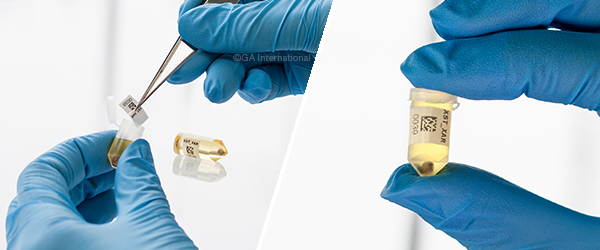 First discovered in the 1950s, transmission electron microscopy (TEM) is now one of the most widely used techniques to resolve cellular structures. It bombards a specimen with an electron beam, which is focused with magnetic lenses to give an extremely high-resolution image, making it possible to view subcellular organelles—and sometimes full atoms and molecules—with much more precision than either light or confocal microscopes can provide.
First discovered in the 1950s, transmission electron microscopy (TEM) is now one of the most widely used techniques to resolve cellular structures. It bombards a specimen with an electron beam, which is focused with magnetic lenses to give an extremely high-resolution image, making it possible to view subcellular organelles—and sometimes full atoms and molecules—with much more precision than either light or confocal microscopes can provide.
Preparing the sample
To properly view samples for electron microscopy, tissues are first fixed, usually with either formaldehyde or glutaraldehyde. Once fixed, the samples need to become embedded in a medium that will secure the structure of the tissue so that they can be cut into thin sections. Epoxy resin is one of the best materials to embed with since it can form a solid matrix once it’s cured at 60°C (140°F), making it easy to cut sections thinner than 0.1 μm with an ultramicrotome, preferably with a glass knife, as a metal one could produce wrinkles in the sections. However, before tissues can be embedded, they need to be dehydrated with ethanol or acetone then treated with a clearing agent (usually xylene) to remove the dehydrating agent.
Specimen identification
Labeling these types of samples isn’t easy, as most traditional labels won’t adhere to resin blocks, while labels that are preserved in the capsule along with the sample usually become faded or smudged. The best option is using a specialty label designed for resin-embedded samples, like LabTAG’s patented ResiTAG™, which can be embedded in the capsule or mold along with the sample. These small tags can be printed on with alphanumeric text, serialized numbers, as well as 1D or 2D barcodes, and are compatible with thermal-transfer printers, making the printout resistant to resin, heat (up to 100°C/212°F), 100% ethanol, methanol, isopropanol, xylene, toluene, acetone, formalin, dimethyl sulfoxide (DMSO), and methyl ethyl ketone (MEK). Because the ResiTAG labels are so small, they can easily accommodate almost any capsule or mold size. The labels can be handled without difficulty even when wearing gloves, and the perforations on the label make it simple to fold the label and place it in the capsule or mold. Once inside, additional liquid resin can be poured in to arrive at the final volume. After baking and solidifying the resin, the blocks can be read with a barcode scanner and sections can be cut. ResiTAG also allows you to track your sections, as they can also be used as labels to identify microscope slides containing the cut sections, with barcodes corresponding to the original capsule or mold.
ResiTAG is the most reliable labeling solution for preparing and archiving electron microscopy specimens. As biopsies taken from patients are often embedded in resin at large-scale microscopy facilities, which process hundreds or thousands of samples daily, it is essential that errors are avoided in tracking and identifying samples; biopsies are invasive and sometimes extremely difficult to obtain, so any mislabeled sample may put the patient at risk. Samples can even be rejected by medical testing laboratories if they aren’t labeled properly. Incorporating these tags conserves all your data during short-term and long-term storage, and because these tags come in roll format, they can save materials as you can print the exact number of labels needed. Altogether, ResiTAG will ensure the proper identification of specimens embedded in resin, reducing errors, and enhancing their traceability.
LabTAG by GA International is a leading manufacturer of high-performance specialty labels and a supplier of identification solutions used in research and medical labs as well as healthcare institutions.



